Try Default

See how revenue teams automate revenue operations with Default.

Key Takeaways
The modern sales team faces a seemingly impossible task: grow revenue while facing tighter budgets. One potential solution to this problem is the AI SDR, which can increase the number of leads you’re able to service without ballooning costs.
In this article, we’ll look at the role AI SDRs play in modern sales operations, whether it can be a good fit for your organization, and how to choose the best tool.
What is an AI SDR and how does it work?
An AI SDR is a digital tool that uses artificial intelligence to prospect, qualify, nurture, and otherwise survey inbound and outbound leads. Basically, it does all the tasks that you’d expect from a human SDR.
As with their human counterparts, AI SDRs have different focuses within different organizations. Some may handle the whole prospecting process, while others may focus exclusively on qualification or other stages of the prospect journey. In the latter case, AI SDRs will likely integrate into your existing sales workflow software and RevOps tech stack.
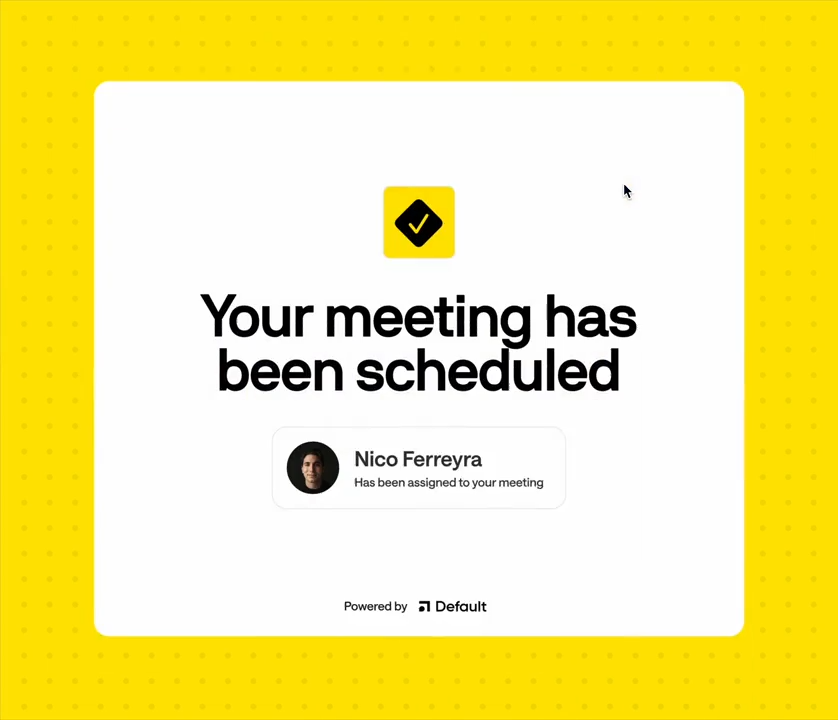
4 benefits of AI SDRs
Although artificial intelligence is hardly a new technological development, in recent years “AI” is having a moment. But despite the (understandable) skepticism that it may be a fad, AI truly does have benefits that can improve how sales prospecting and management works.
Smarter personnel deployment
There are plenty of aspects of the SDR job description that are monotonous and time-consuming. These include lead qualification, creating new profiles in the CRM, data entry, booking meetings, etc. But they have to be done.
An AI SDR can automate many of these tasks, clearing up hours of your team’s time over the course of a week. Human SDRs can spend this time researching prospects, writing personalized communications, preparing for presentations, engaging in outbound outreach, and other activities that generate more pipeline.
Cost-effective scalability
In times of uncertainty, organizations are hard-pressed to increase their operational costs too much. This is true in sales as much as any other function or department.
However, the need to continue growing doesn’t just go away. This leaves sales organizations in the bind of having to do more with less.
AI SDRs, rather than threaten human sales reps, can help you to scale your sales team without dramatically increasing your personnel costs. In other words, it enables your SDRs to ramp up their individual quotas, which ends up improving the ROI of your sales budgets.
Increased availability & response times
We’ve talked before about how speed is a critical component of turning inbound (and outbound) leads into paying customers. According to data from HubSpot, customers expect a response within 10 minutes.
But even global sales teams aren’t available 24/7. That’s where an AI SDR can fill in the gaps. The bot can respond to off-hours requests in real time, giving the prospect a sense of priority and urgency. Then, when your team is back online, the bot can “pass the baton” and let a human SDR take it from there.
Create a seamless prospect experience
From conversion to MQL to SQL to opportunity to closed-won, a consistent sales experience is key to avoiding friction and increasing the likelihood of conversion. That’s one reason sales teams try to keep the same accounts with the same lead.
But you can’t guarantee that the account owner will always be available. Whether they’re sick or on PTO or OOO, there are situations where you’ll hand off the account to another rep who can provide an immediate response.
This can create a disruptive experience that puts the buyer on edge. Although it’s not a perfect replacement, integrating AI SDRs into your RevOps software workflows can offer a stopgap so buyers don’t bounce around your sales team.
Comparing human vs. AI SDRs
For better or worse, every conversation around AI ends up in some version of “humans vs. AI.” People are worried that robots are coming for their jobs—this is nothing new.
At Default, we don’t think this dichotomy is the right way to frame the AI discussion. Although AI can perform some tasks better than humans, there are some things humans do better. The conversation should be about how AI helps humans increase their own performance and productivity, not an either-or.
Additionally, AI is only as good as the data you feed it. “Humans vs. AI” as a framework obscures that reality. An AI trained with bad data could perform worse than a human SDR, while one trained with top-shelf data can knock them out of the park.
So while there’s a ton of nuance in this conversation, comparing human vs. AI SDRs can surface some interesting points. Let’s briefly consider the pros and cons of each.
Human SDR advantages
Excellent at unscripted scenarios—can adapt to buyer questions and personalize their sales pitch in real time
- Understands the qualitative factors influencing buyers, not just the raw data or numbers
- Fosters personal connection through human interactions: humor, storytelling, empathy, etc.
- Reads implicit cues and can often get at the “answer behind the answer”
Human SDR disadvantages
Limited availability in a 24/7 world
- High cost to hire and maintain (base comp + commissions + bonuses + benefits)
- Lack of consistency among messaging and positioning, which requires extensive call listening and coaching to correct
AI SDR advantages
- 24/7 availability, which can dramatically improve speed-to-lead
- Highly scalable, enabling you to do more with fewer human resources
- Handles monotonous tasks, freeing up your human SDRs for more personal tasks
AI SDR disadvantages
- Handles a limited number of use cases (e.g. qualification, scheduling)
- If improperly trained or used for inappropriate use cases, it can create a jarring and unpleasant user experience
- Can’t handle unscripted scenarios well—which can frustrate customers
The best 5 AI SDR tools, at a glance
- Default
- AiSDR
- Ava by Artisan
- Piper by Qualified
- Clara
1. Default
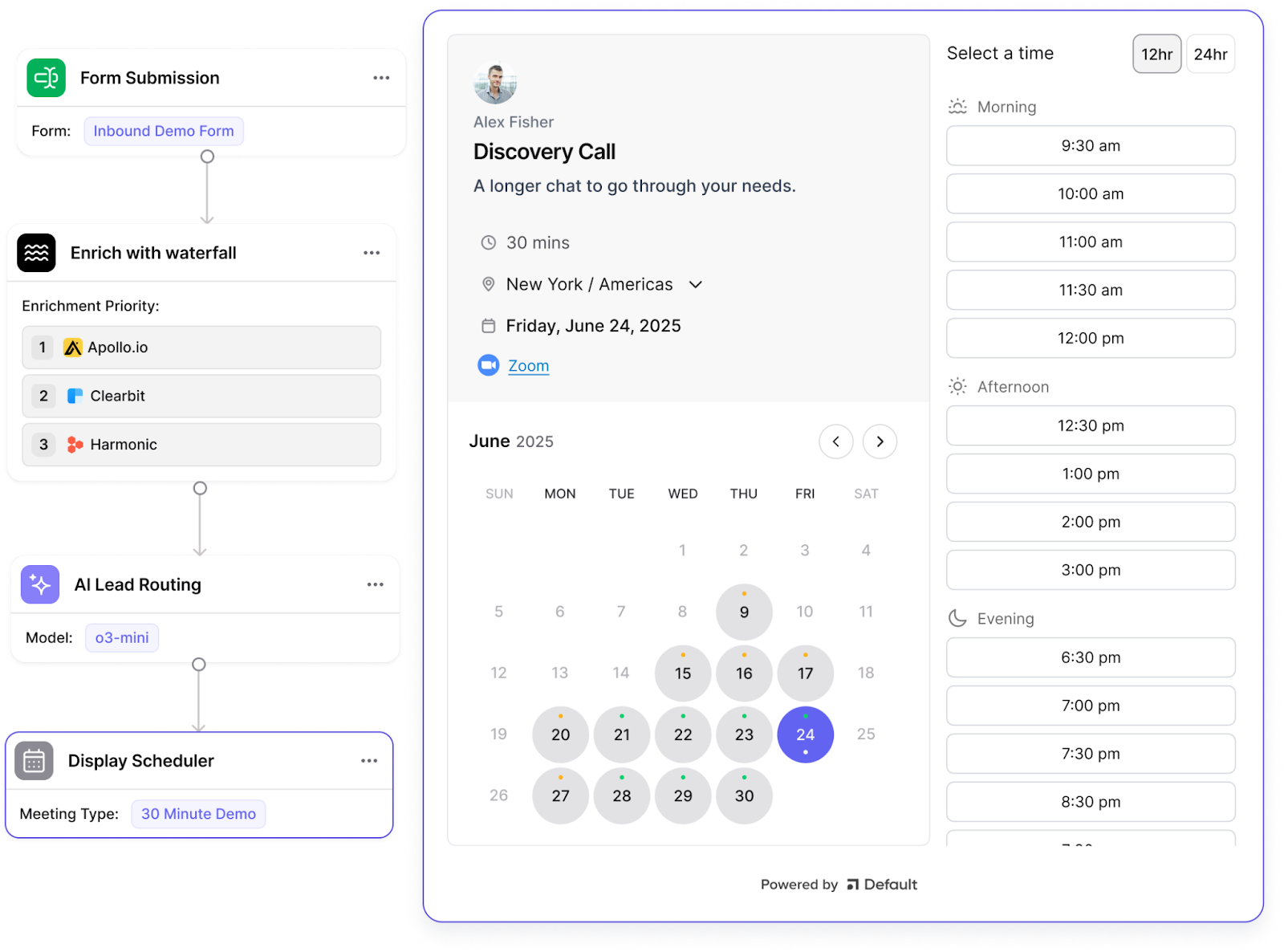
Default is far and away the best AI SDR tool on this list for one simple reason: our platform doesn’t try to force-fit AI into a role that doesn’t suit its strengths.
Rather than replace the irreplaceable human interactions that SDRs offer customers, we automate back-end processes like CRM contact creation, enrichment, qualification & lead scoring, routing, scheduling, and follow-up to free up SDRs for those tasks that only humans can do.
Features
- AI SDR processes triggered automatically by form submissions and completed the workflow within minutes
- Automated contact creation within your CRM and real-time enrichment with AI-updated data (Clearbit & Apollo.io)
- Instant lead routing and scheduling based on round-robin or rules-based workflows
- Fully customizable automations for ongoing follow-up and nurture
Limitations
- No front-end AI SDR chatbot or “conversational” tool
- Not a point solution—meant to be an all-in-one SDR and sales workflow tool
- Predominately used to handle inbound SDR and enterprise sales use cases
Pricing
Default has three pricing plans, but only the Studio and Scale plans offer all the features necessary for AI SDR functionality. For more information, schedule a Default demo today.
→ Embed Book a Demo Page CTA 🚨
2. AiSDR
AiSDR is a bare-bones, outbound solution that automates email, SMS, and social media sales outreach. Despite its limited functionality, it has plenty of rave reviews on G2—so it handles its use case very well. As such, it’s earned a place on our list.
Features
- Integrated prospect research through Apollo.io and RocketReach, as well as automated enrichment of your own manual or Sales Nav data
- Automated email outreach with built-in calendaring and domain warm-up
- CRM integrations to enable advanced lead tracking and analytics
Limitations
- Limited, point solution functionality: it’s essentially a more advanced email automation platform with some CRM integration
- Only works for the outbound SDR use case—no inbound management features included
- G2 reviews on RocketReach’s data accuracy are mixed, which could hinder the platform’s usefulness
- Some features tend to favor the services use case over software or other products
Pricing
AiSDR has a $750 per month Basic pricing plan that includes 1,000 emails, text messages, unlimited leads & seats, domain warm-up, and dedicated support. There are volume discounts for more than 1,000 emails.
3. Ava by Artisan
Artisan plans to take the marketing and sales world by storm, creating AI tools (called “Artisans”) to work alongside human beings. While we’re skeptical about that grand vision, their AI SDR tool called Ava is impressive.
Features
- Automated prospecting through automated research and email deployments
- Built-in lead enrichment and qualification
- AI-generated outbound emails and responses
Limitations
- Difficult to say, as there are currently no reviews on G2
- AI-generated emails are typically very stilted or overly fluffy—it’s clear that a bot wrote them and not a human being. This can end up hindering the outbound process.
- Most of Artisan’s enrichment data comes through web scraping, and thus likely faces accuracy challenges
- Ava’s functionality is highly limited, even if you consider the wider Artisan sales automation platform
Pricing
Artisan doesn’t provide public pricing data on their website to determine how much it costs to purchase their Ava tool.
4. Piper by Qualified
As far as enterprise AI solutions go, Piper by Qualified is a strong choice. With conversational AI, automatic bookings, and instant inbound response, it’s clear this AI solution has the power to handle the influx that powerful inbound engines offer.
Because Qualified uses Piper on its website as their own AI SDR solution, we were able to play around with it and see how it handled our questions.
Features
- Automated front-end conversations that run on autopilot (AI-only engagement) or copilot (filtering and routing leads to human SDRs)
- Integrated calendaring at the point of conversion
- Instant qualification and lead nurture
- Built-in, customizable guardrails to ensure the AI doesn’t go off the rails
Limitations
Funny enough, we asked the Piper AI SDR about its limitations. Its response: Piper works best with a Salesforce-centric tech stack, and probably isn’t the best fit if you aren’t a Salesforce user. Points for transparency and honesty!
When engaging with Piper, however, we found that it had trouble coming up with responses to out of the box questions. We told Piper we were conducting a review of AI SDR tools for a feature article, and it struggled to give a helpful answer. This is a perfect example of how an AI has trouble thinking on its feet and coming up with off-the-cuff responses that a human SDR doesn’t.
Pricing
PiperAI is only included with Qualified’s Premier tier and above. Although there’s no pricing available on the website for this tier, the one directly below it starts at $3,500 per month. So expect to pull out your money bags to get access to this tool.
5. Clara Labs
We’ve reviewed Clara Labs before, and we’ve included it on this list simply because of its simplicity and ease of use. Sometimes, sales teams can overcomplicate their tech stack, but Clara pushes back on this trend and has a straightforward UX/UI.
Features
- Conversational intelligence platform with built-in meeting scheduling features
Limitations
- Point solution with really only one core feature—although this will likely grow over time
Pricing
No public pricing data is available on the Clara Labs website.
How does an AI SDR improve your sales workflow?
Even the best sales workflow software tools can be improved through the use of an AI SDR. It all depends on where you deploy it and how. Here are some examples from each stage of the typical sales process.
Lead gen
Just because a person fills out a demo form doesn’t mean they’re a lead. A good 60-70% of form submissions never convert into a booked meeting. Which means that, for any practical or business reason, they aren’t truly a lead.
AI SDR tools can help turn form submission into leads in two ways. First, they can prompt the lead to schedule a meeting as soon as they convert. According to Default’s proprietary data, this can boost speed to lead by 240X.
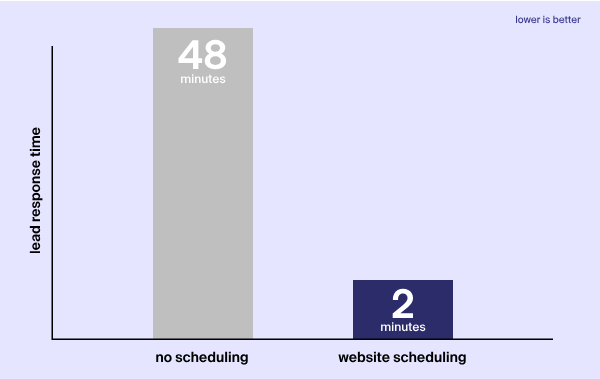
Another way to improve lead generation efforts is to automate follow-up with leads that don’t end up scheduling a meeting. Our data shows that this can lift conversions by 14%.
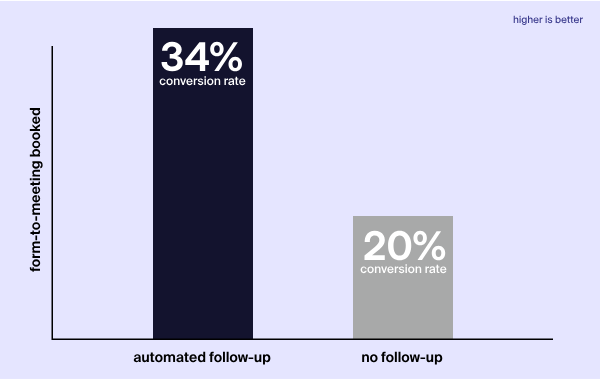
CRM
One of the biggest time sinks among sales reps is the constant stream of manual tasks: creating records, taking notes, updating records, researching leads, inputting the results of that research into the CRM.
Sure, you need that data. But it’s exhausting to capture it.
An AI SDR tool can also help improve the quality of your CRM data, which in turn improves your lead qualification and lead scoring accuracy. There are a couple of ways this can happen. Most of the tools we’ve reviewed here capture data on the front end: asking questions and getting leads to submit data.
The problem is that the more questions you ask, the more friction you create. This is true whether it’s a human being or AI tool on the other end.
There’s a far better way to use AI to improve your CRM, and that’s through automated lead enrichment. With this approach, your AI SDR creates a new record or matches the lead to an existing record, and pulls in third-party data to provide as much information as possible.
Lead qualification
When it comes to inbound lead qualification, revenue leaders are in a bit of a bind. On the one hand, you need more than just a name and email to determine whether the lead is a good fit. On the other hand, form fields with fewer than five fields have a 200% higher conversion rate than those with more.
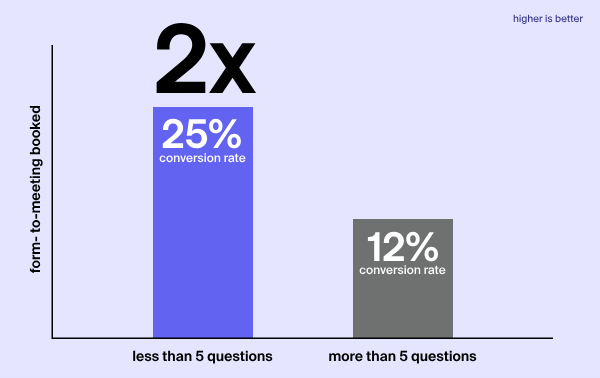
Just like we talked about with regard to the CRM, automated lead enrichment also helps improve your lead qualification efforts.
Inbound & outbound communication
Marketing and sales communication, whether inbound or outbound, has become so over-automated that people are ignoring them. In fact, in a B2B context, professionals ignore about 60% of the emails that make it to their inbox.
Because of this, it seems the pendulum has swung to the opposite extreme, and people are questioning whether automated sales emails are worth it.
The answer, of course, is yes—but you have to do it the right way.
When AI SDRs just copy and paste the same canned language to all your contacts, that’s sure to fail. When they help connect your leads with a salesperson that has the same industry experience, product expertise, and other attributes that enable a human connection, it can save you time while maintaining a personal touch.
Lead routing
Not only do human SDRs spend significant time researching and qualifying leads, but they also route them to salespeople best positioned to close them. Regardless of whether you distribute leads through round robin or through rules-based workflows, lead routing is a task that an AI SDR is perfectly equipped to handle.
In fact, as your inbound lead volume reaches a certain size, you’ll find that human SDRs won’t be able to route leads fast enough to enable a response within five minutes. AI SDRs, then, can have an outsized impact on both speed-to-lead and meeting conversion rates.
How can AI SDRs help to automate inbound sales?
Let’s face it: front-end AI tools are clunky. They often answer the wrong questions, and can create serious dissatisfaction among customers. What’s more, if you constantly direct people to talk to a robot instead of a human person, it can make them feel like they’re not valued or important.
As such, we recommend using AI not on the front end, but the back-end. Rather than replace human-to-human connection and rapport, use AI to automate monotonous tasks to accelerate and scale those interactions.
AI SDRs can help automate inbound sales in four primary ways:
- Automatic contact creation, lead research, and enrichment, which saves 12 minutes per lead on data entry (per Default’s recent research)
- Fast qualification (as much as 31% faster, per Default’s recent research) through AI-powered lead scoring models that use both quantitative and qualitative data to determine a lead’s fit
- Real-time routing and scheduling, which increases the likelihood of booking a meeting
- Ongoing lead nurture through automated workflows
A common mistake companies make is to use separate platforms for each of these functions. Unfortunately, given the disparate quality of AI algorithms these days, that can be disastrous.
Instead, use one AI tool to handle all of these functions and ensure consistency among your sales team.
→ Embed Book a Demo Page CTA 🚨
AI SDR FAQs
Will AI replace human SDRs?
Absolutely not. While some tasks (e.g. contact creation, lead scoring, and lead routing) will be handled by AI SDRs, humans will continue engaging contacts and building the rapport and trust necessary to close more deals. In fact, AI SDRs can enable human sales teams to increase their quotas without having to dramatically expand their teams.
What does SDR stand for in sales?
SDR stands for “sales development representative.” This is typically a front-line salesperson responsible for sourcing, qualifying, and routing inbound and outbound leads. In many cases, they’re also responsible for closing small and mid-sized deals.
Final thoughts on AI SDRs
As more and more sales teams lean on AI to meet quotas and improve operational efficiency, the use of AI SDRs is only going to increase. It’s not a question of if AI will take over the modern sales stack, but when.
So ask yourself: how are we going to use AI strategically? Specifically, how can SDRs leverage AI to scale their own efforts, accelerate lead generation and conversions, and get more meetings onto their AE’s calendar?
The answer: use an all-in-one platform to automate your SDR processes to enable more human interactions.
Your prospects will love it, and your competitors will hate it. That’s a win-win in our book.
→ Embed Book a Demo Page CTA 🚨
Conclusion

Former pro Olympic athlete turned growth marketer! Previously worked at Chili Piper and co-founded my own company before joining Default two years ago.
Accelerate your growth with Default.
Revamp inbound with easier routing, actionable intent, and faster scheduling















.png)














%201.svg)



.svg)





%201.svg)




%201.svg)

